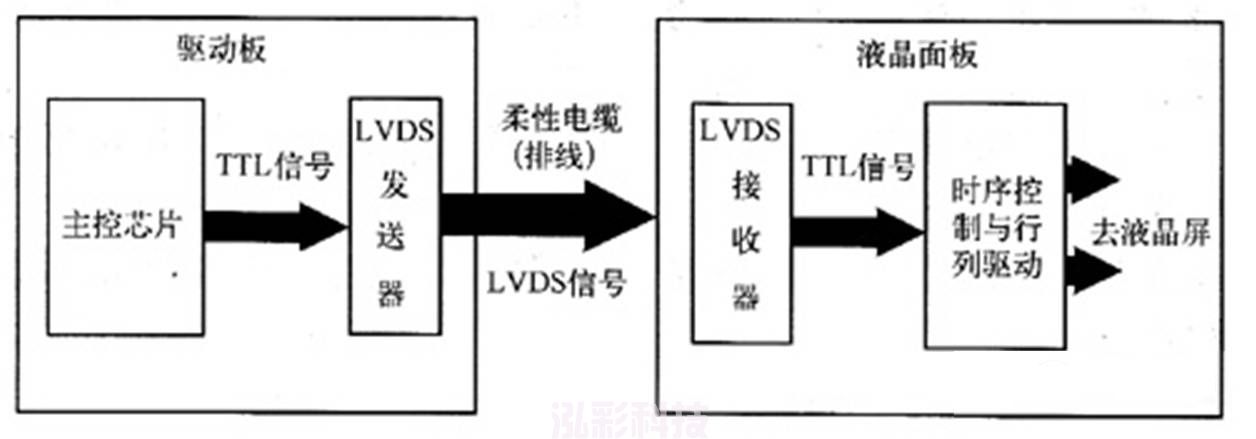The LVDS interface in the tft lcd display interface is also a common communication interface. LVDS is the abbreviation of “Low Voltage Differential Signaling” in English, which means low voltage differential signal. It is a low-voltage differential signaling technology interface. It is a digital video signal transmission method developed by American NS Corporation (National Semiconductor Corporation) to overcome the disadvantages of large power consumption and large EMI electromagnetic interference when transmitting broadband high-bit-rate data in TTL level mode.
LVDS interface features
The LVDS output interface utilizes a very low voltage swing (about 350mV) to transmit data differentially on two PCB traces or a pair of balanced cables. Signals can be transmitted at a rate of several hundred Mbit/s on differential PCB lines or balanced cables. Due to the low-voltage and low-current driving methods, low noise and low power consumption are achieved. At present, the LVDS output interface has been widely used in 17in and above LCD liquid crystal displays. Using the LVDS interface, signals can be transmitted at hundreds of megabits per second on differential PCB lines or balanced cables. Due to the low voltage and low current driving method, it has the advantages of low noise and low power consumption. In LCD color TVs, LVDS lines mostly use balanced cables, which are actually twisted pairs.

LVDS interface circuit composition
The TFT LCD display first decodes the input signals (such as TV, AV, etc.) to obtain RGB signals. The processing process is basically the same as that of ordinary color TVs. Then, after RGB-LVDS conversion, LVDS signals are output and sent to the LCD screen. Since the TFT in the LCD screen only recognizes TTL (RGB) signals, the LVDS sent to the LCD screen of the TFT LCD display screen needs to be decoded to obtain the TTL signal.
It can be seen that the LVDS interface circuit includes two parts: one is the LVDS output interface circuit (LVDS transmitter) on the motherboard side, and the other is the LVDS input interface circuit (LVDS receiver) on the LCD panel side. The LVDS sending end converts the TTL signal into an LVDS signal and then transmits the signal to the LVDS decoding IC on the LCD panel side through the cable or flexible cable (often referred to as the upper screen line) between the driver board and the LCD panel. The signal is converted into a parallel signal of a TTL level and then sent to the LCD screen timing control and a row-column driving circuit.
Signal Types of LVDS Interfaces
The LVDS signal is mainly composed of data differential and clock differential signals. The suffix letters “M” and “P” represent positive and negative phases respectively, that is, YX and YXP are a pair of differential lines, and CLKOUT M and CLKOUT_P are also a pair of differential lines.
TFT LCD screen interface LVDS output interface is also divided into the following four types:
(1) Single-channel 6-bit LVDS output interface
In this interface circuit, single-channel transmission is adopted, and each primary color signal adopts 6-bit data, a total of 18-bit RGB data, so it is also called an 18-bit or 18-bit LVDS interface. This is also called an 18-bit or 18bitLVDS interface.
(2) Dual 6-bit LVDS output interface
In this interface circuit, two-way transmission is adopted, and each primary color signal uses 6-bit data, of which the odd-channel data is 18 bits, the even-channel data is 18 bits, and a total of 36-bit RGB data, so it is also called 36-bit or 36-bit LVDS. interface.
(3) Single-channel 8-bit 1TL output interface
In this interface circuit, single-channel transmission is adopted, and each primary color signal adopts 8-bit data, with a total of 24-bit RGB data, so it is also called 24-bit or 24-bit LVDS interface.
(4) Dual 8-bit 1TL output bit interface
In this interface circuit, two-way transmission is adopted, and each primary color signal uses 8-bit data, of which the odd data is 24 bits, the even data is 24 bits, and a total of 48 bits of RGB data. Therefore, it is also called 48-bit or 48-bit LVDS. interface.
Shenzhen Hongcai Technology Co., Ltd. is a professional manufacturer of small and medium-sized, 1.77-inch LCD LCD screens, 2.8-inch LCD LCD screens, and LCD display screens. It mainly produces 8-bit and 16-bit LCD screens, which are widely used in different high-tech industries. , the factory also supports industry customization, re-change the definition of PIN, stable resources, stable quality, cheap and affordable prices, and welcomes customers in need to directly click on the online consultation.

